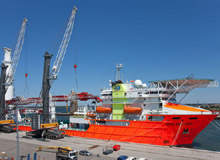
Although few would deny that times are still far from easy, during 2009, the heavy lift sector has helped inject a welcome ray of optimism into the offshore and shipping industries, amid the general doom-and-gloom mood of the beleaguered global economy.
While European ship building in general has been hit hard – and many commentators say that it may be another 12 or 18 months before the full impact will really be felt as most yards are still engaged on contracts signed in healthier days – the news seems better for the heavy-lift sector.
Schiffahrtskontor Altes Land (SAL) managing director Lars Rolner says that the sector should start see a recovery earlier than many parts of the shipping industry. “The global economic crisis has also had an effect on the sector; however, we are already seeing signs that the market will recover in 2011,” he says.
There is clearly a real belief behind those words – this is a company that commissioned the Sietas shipyard in June for two next-generation heavy-lift vessels, at an estimated cost of €120m.
Bigger, stronger, deeper
The growing move towards heavier lifting operations at increasingly greater depths is one trend that seems universally tipped to continue into the future, along with the concomitant development of ultra-deepwater technologies to extend offshore crane capacity. MacGREGOR’s innovative fibre-rope technology, which overcomes the limits imposed by the weight of traditional steel wire at depth, and the state-of-the-art electro-hydraulic drive systems of Liebherr’s new MTC 78000 crane are two such examples, and others will surely follow. The signs are already there.
Two months after the first MTC 78000 – one of the largest offshore slewing cranes in the world – was delivered to the heavy load vessel OSA Goliath, Jumbo’s fourth and latest J Class vessel, MV Jumbo Jubilee, set a new tandem heavy-lift record during tests at the Huisman yard in Schiedam. At 1,992t, the ballasted pontoon lifted by the two 900t mast cranes – the heaviest load ever for a heavy-lift transport ship – exceeded the required 10% over combined safe working load to meet Lloyd’s Certificate of Compliance conditions by 12t.
On the very same Saturday in August, and just five miles further east at Krimpen aan den Ijssel, another record was being made as the Oleg Strashnov was launched for Seaway Heavy Lifting. Equipped with 5,000t crane capacity, this is the largest mono-hull heavy-lift vessel in the world – and the largest ship ever built by IHC Merwede.
Admittedly, such developments do not herald anything like the sort of quantum leap for the sector that the arrival of the Balder and Hermod semi-submersible crane vessels did back in 1979 but 30 years on and ‘bigger, stronger, deeper’ remains just as relevant. Follow this rolling momentum to its logical conclusion and many believe that a natural and obvious impetus emerges that will inevitably tend to favour designing cranes with greater capacity and height. If so, then the challenge here may lie in how effectively novel heavy-lift technologies can be outlined, how readily any new breed of supercranes can be fabricated and how large a part aging and obsolescence will ultimately play in dictating what constitutes a cost-effective and time-efficient lift.
The safety challenge
Within the oil and gas industry, the growing need to decommission platforms is likely to form another major influence on the long-term shape of the heavy-lift sector, since neither the physical challenge of removing infrastructure offshore, nor the attendant procurement logistics seem destined to be straightforward. It is, then, hardly surprising that both Liebherr’s new crane and the Oleg Strashnov should have been designed with just such projects firmly in mind.
But in looking at the wider context it becomes clear that safety is the one over-arching issue that, in various guises, appears set to dominate much of the industry’s thinking over the coming years. While the principal focus naturally falls on risk analysis, planning and the directly operational aspects of the lifts, driving the proliferation of leading-edge safety features within equipment, one recently formed sector group suggests that there is a more insidious challenge to face.
The International Council of Heavy Lift and Project Cargo Carriers – known as the ‘Heavy Lift Club’ – says the explosion of containerisation in global trade has altered the face of ports and dock-side labour to the point where safety is becoming compromised for break-bulk and heavy-lift shippers.
and project cargo carriers are crucial to world infrastructure.”
While many port authorities and investors have been busy prioritising container terminals, heavy lift facilities have been largely neglected. Heavy Lift Club chairman Jan Boje Steffens says that although it is a criticism that does not apply universally, in many parts of the world, the lack of suitably qualified stevedores and the growing use of labour pool workers – most of whom are more familiar with container operations – has had a negative consequence on the safety of cargo handling.
Shaping the future
In the long run, if Lars Rolner’s reading of the signs of recovery is right, the heavy lift sector faces potentially interesting times ahead, even though there may not be a complete consensus on where the opportunities will lie as yet. Issues surrounding ultra-deep lifts, modularisation, decommissioning, safety, extending crane capacity and the production of bigger and better heavy lift vessels and equipment remain heavily debated.
What is clear is that it is inevitable market forces and technological innovation will continue to mould the shape of the sector every bit as much over the next decade, as they did in the previous one. At the founding of the Heavy Lift Club in May, Steffens was keen to stress the importance of this technology – and the heavy-lift sector in general – on global infrastructure. “Heavy-lift and project cargo carriers are crucial to world infrastructure, which affects everyone. The work of heavy-lift and project cargo carriers is not only important, it is specialised,” he said.



